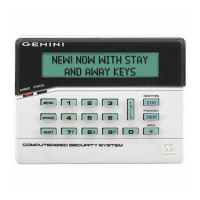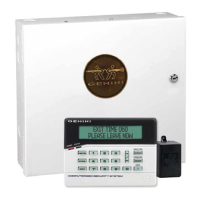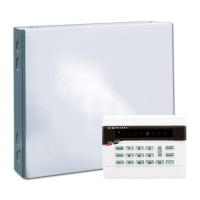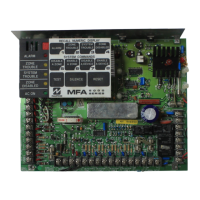X
GEM-P1632 Installation Instructions
L
NAPCO Security Systems
WI808F 8/03
!
Page 38
which causes the communicator to wait before it attempts to detect a dial tone (see Dial-Tone Detection). Certain telephone exchanges
send a nonstandard dial tone that the communicator may not be able to detect. With these nonstandard exchanges, it is possible to
program Pre-Dial Delay rather than Dial-Tone Detection. This will cause the communicator to wait for a 4 second time period before
dialing.Contact the telephone-equipment supplier to find out how long a delay is required before dialing. Select “Pre-Dial Delay” by
programming one “D” for each 4-second delay required immediately before the telephone number. Note: In UL installations, do not
program more than one “D” before the telephone number.
See Backup Report on Telco 2; Report Telco 3 (Double or Split Reporting). Also see Access Number for Outside Line; Telephone
Numbers.
Print Module Support
The bus mounted GEM-PRINT will print all system activity. If the GEM-PRINT fails, it will cause an E27- 00 Printer Fail system trouble.
Priority Area Arming
Prevents area arming if the alternate Priority Area has not yet been armed.
Priority Zone (Required for all zones in UL installations.)
A zone that will prevent arming if faulted. If an attempt is made to arm, the sounder will come on and “
ZONES NOT NORMAL / CAN'T ARM
”
will be displayed for 4 seconds. The keypad may be reset by simply pressing the
C button. The fault on a Priority Zone must be
corrected before the panel can be armed. Any zone may be selected as a Priority Zone. A zone in trouble that is neither a Priority Zone
nor an Auto-Bypass Zone will cause an alarm on arming.
Priority Zone with Bypass
A Priority Zone that will permit arming if the priority condition is bypassed. If the system is so programmed, the zone will auto-bypass
and (optional) the condition will be reported to a central station.
As above, if an attempt is made to arm, the sounder will come on and “
ZONES NOT NORMAL / CAN'T ARM
” will be displayed. To reset the
keypad, press the
C button; the display will read “
ZONE FAULTS
”. To arm the panel, press the B button, then enter the zone
number, then press the
U
button. Any zone not selected as a Priority Zone may be programmed as a Priority Zone with Bypass.
Pulse Burglary Output See Alarm Outputs
Receiver Format
The communicator can be programmed to transmit to any standard central-station receiver format. A receiver format must be entered
for each telephone number used, but a different format may be assigned to each. Refer to Backup Report on Telco 2 and Report Telco
3 to determine whether or not Telephones 2 and/or 3 will be programmed. Call the central station for each telephone number used to
confirm the type of receiver in use. Select the receiver format entry for each telephone number from the following table.
*These formats do not use programmable codes, but Event ID Codes to identify the type of zone and alarm as follows:
1 – Fire
2 – Panic
3 – Burglary
4 – Holdup
7 – Gas Alarm
8 – Heat Alarm
A – Auxiliary Alarm (keypad displays “0”)
B – 24-Hour Auxiliary Alarm
Relay Control (Optional External Relays)
In addition to the three relay outputs (Alarm, PGM1 and PGM2) provided on the motherboard, up to 8 external relays can be controlled
from the keypad through the use of the RM3008 (self-contained) or the RB3008 (to be mounted inside housing). The GEM-OUT8 is
similar to the RM3008 but has open collector active low outputs in place of relays. The GEM-OUT8 is designed for external remote
mounting. One module is needed for the GEM-P1632 Control Panel, although up to 12 may be used. Use the RM3008, RB3008 or
the GEM-OUT8 for 8 independent programmable active low outputs for controlling sixteen relay events (Address 0750-0829), which
Glossary
ENTRY RECEIVER FORMAT
blank (•) Ademco, Silent Knight Slow
2 Radionics Fast
3 Silent Knight Fast
4 Radionics, DCI, Franklin Slow
5 Universal Hi-Speed
B SIA*
C Ademco Point ID*
E Pager
DATA
FREQ.
(Hz)
DUTY CYCLE
(ON/OFF)
INTERDIGIT
TIME
1900 60/40mS 600mS
1850 13/12 400
1900 40/30 560
1800 60/40 600
1850 30/20 350
Modem formats

